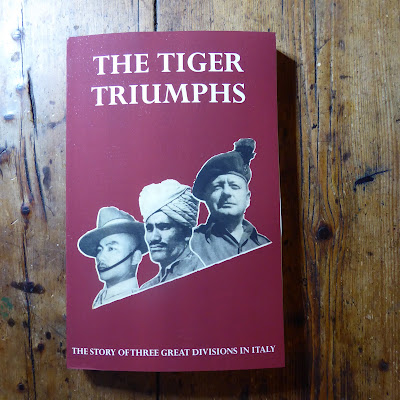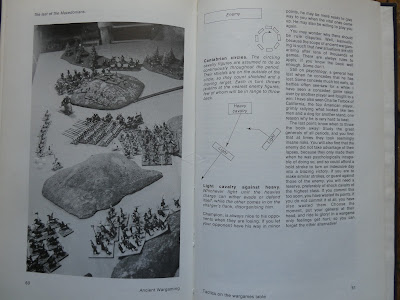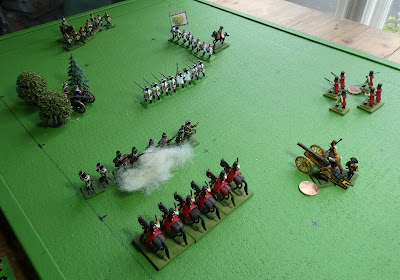As The Ragged Soldier marches onward, a small milestone has appeared by the roadside : this is my 100th blog post. I'm rather pleasantly surprised to have come this far, and have thoroughly enjoyed both the process of creating the blog posts and the results. Thanks to all who have dropped by, and in particular I'd like to say a big 'thank you' to the elite club of 39 who have signed up to follow the blog, and especially to all who have left ( unanimously ) friendly and supportive comments.It's fantastic that so many of you have spared some of your time and contributed your always informative and often amusing thoughts.
As is ( I think ) traditional, I will take the opportunity for a short break from the forward march, have a sit down on the roadside, lean back on the convenient milestone, open up the kitbag and take stock of the contents, and ponder where the march might take us next.
Most of my effort so far has been devoted to the Seven Years War period, with the troops acquired from the late Eric Knowles collection. The campaign based loosely on the 'Soldier King' boardgame worked out really well, and generated some interesting battles at a variety of different levels, from a small cavalry raid on an isolated outpost to the grand culminating engagement at Zouache. That's the advantage of running a campaign, I'm sure - the unpredicatability and challenges of the different games that come up. The campaign has reached 'winter quarters' with Prussia most certainly in the ascendant, and I think perhaps the Austrians will be seeking terms for a peace agreement, or at least some sort of truce. I think I will continue with this setting for my 7YW games; the question I am debating is whether to resume the campaign as a simple continuation into the new campaigning season, or re-join the story after a period of peace and recovery.
Meanwhile some good news I have ( finally! ) completed painting the first two units of Prussian 9th Infantry 'Jung Kleist' regiment, from my 40+ years old Minifigs, and here they are:
Button counters and posh painters look away now, I'm afraid, but they will 'do' for The Ragged Soldier - though I think they need to work on dressing their ranks a bit better in any future pictures! Also I need to colour in the edge of that standard ( bought at the 'Broadside' show from Flags of War ) before they go on campaign. Very simple block painting is my 'style' and the limit of my abilities - if I tried anything more complicated I'd never get any finished! The Osprey book I used for guidance had fantastic detail of the different arrangements of 'lace loops' on the lapels, cuffs, coat-tails etc for every regiment, and I initially thought I might try to apply that - and then realised 'with my eyesight and co-ordination- no way'! So they got a dab of white at the cuffs and that will do.. they won't fight any worse!
There are more of those Prussians, and plenty more unpainted figures waiting their turn - including the contingent generously gifted by Neil Patterson of Aufklarungsabteilung fame, who I hope will become the army of Saxony, some interesting Austrian border troops, and some nice French Dragoons in their distinctive 'nightcap' headgear. If I can keep up a 'little and often' painting routine, more of these chaps should be available for mobilisation and use in future campaigns. So, with 7YW it's a case of just keep painting and carry on..
The D-Day Dodgers ( World War 2 in Italy ) has stalled a bit, only one game played so far, but I have ideas - I've been reading 'The Tiger Triumphs', which is the official British Army account of the progress of 4th, 8th and 10th Indian Divisions in Italy from 1943 to 1945, and it's been splendid stuff. Admittedly this isn't an objective and balanced account - indeed, 'gung ho' seems appropriate -but it does convey a lot of atmosphere, and the mindset of those who were actually there. I've read it with a modern map of Italy ( 1 cm to 4km ) close at hand so as to follow progress, and that has helped no end. Describing fighting near San Marino in September 1944, we have 'of this battle, as of nearly every battle in Italy, the story is really of two battles - the storming of the high ground by the infantry, and the equally grim fight against time by the sappers and armour to construct crossings and to get support weapons forward before the enemy could throw his reserves at the newly won positions'. The Germans certainly did not simply stand on the defensive - there are challenges for both sides. It strikes me that the Italian campaign involves markedly different terrain to North-West Europe, including quite a lot of mountains! And not just wheel-to-wheel tanks, either. I think that will make it more interesting, certainly 'different'.
It might be fun to feature the Indian troops quite prominently - given that in the Indian divisions, each brigade always contained one British battalion, I think I may be able to place my fictional 'West Suffolks' infantry into an equally imaginary Indian Brigade battling though Italy. Obviously I will need to get some Indian troops mustered - I have some figures , and am now researching a bit about the various Indian regiments, and which can be portrayed using the dress (especially headwear) of the available figures. Unit organisations are going to be inspired by the Rapid Fire rulesets, and Rapid Fire Reloaded looks like it might be a good choice for rules for the games, perhaps alongside 'The Portable Wargame'. See the picture below for a Rapid Fire organisation - British infantry battalion with attached armour and artillery.
 | |
| I may need more Bren Carriers.. |
So, the next steps with this are simply to get some Indian troops organised and painted, and get them into some sort of action - also think a bit more about terrain. I may need more hills, too..
The third mainstay will I hope be the 'Pike and Shot' period, and I am deterimined to get this going pretty soon. 'Back in the day' this was my main interest, hence the title and quotation at the top of this blog, so I feel the need to live up to the billing!
Having been interested in the period all these years, I knew I had picked up a few sets of rules - so I thought 'let's get them all together and see what we've got'. Well, here's the collection:
 |
| what several decades of impulse buying can achieve.. |
I had not realised just how bad my rules-buying habit had been... Fifteen in all, do you recognse them? The bottom row is proper vintage, along with the original Forlorn Hope, which I think I rather liked ( the green cover, top centre with sadly decapitated title is Renaissance Principles of War by T.M. Penn of Leominster, Herefordshire, c.2000 - I have no memory of acquiring, let alone playing, those ! ). George Gush's and Terry Wise's rules ( bottom right ) go right back to the start, late 70s/early 80s, happy days indeed! It would be great to eventually try every set, but I suspect that is a long shot - but I wonder about little experiment to compare and contrast certain basic mechanisms. It might be quite interesting to just have a couple of foot regiments opposing each other, and play out the 'advance, give fire, charge!' sequence under each of a selection of rulesets, to see how they work. That could be instructive..
But that's not all - there are two more recently-acquired sets waiting in the wings:
I like the look of both In Deo Veritas and Twilight of the Divine Right , especially as they both aim to play 'big battle' games, and that seems eminently possible given the relatively small armies of the period. In Deo Veritas acknowledges the inspiration of good ol' Volley and Bayonet, so they can't be all bad. I mean to get a game set up with at least one of these quite soon, Until now I have told myself I will review my available figures, sort out the basing so it's all standardised ( and magnetic ) , and give them proper professional flags and standards in place of the terrible teenage efforts they are currently lumbered with, and then put on a game. I think that's not the right approach - I need to get them out, stick them to temporary cardboard bases if necessary, and get them on the table! They've waited long enough.
So far, perhaps all too similar to the thoughts expressed in my 50th Post in early 2021, which just shows how time flies with too little achieved. But I do have a secret weapon this time, in the form of ( I hope) a bit more time to devote to all this nonsense. Such are the joys of redundancy ( I'm not necessarily calling it 'retirement' just yet - that seems, well, so final... but who am I kidding? ) and once all the related admin is sorted out, I do plan to devote more time to the stuff featured on this blog.
As with every other wargamer, there are many, many more 'projects' that take one's fancy for a while and may or may not go anywhere - for example Alan Tradgardmastare mentioned the other week that Lamming miniatures were available again, and I was leafing through a vintage copy of Phil Barker's DBA, and thinking 'just a small number of figures - Greeks and Persians?' Hmmm... And what about 19th Century Europe? I wouldn't mind uniting Italy in 1859, and I have a copy of Bloody Big Battles and Neil Thomas' excellent book on the period - how about 6mm or 10mm scale? I just re-joined the Continental Wars Society, too. Marlborough period? Slightly intrigued by the other theatres of war, especially Spain. Italian wars of the 15th/16th Century? Certainly colourful. Then there's air combat - always had a soft spot for that, since Mike Spick and his genius idea of bisected model aircraft kits back in the day.. and so it goes on. Not sure how many of those will ever see the light of day, but one can dream!
For the moment, probably best stick to the three main axes of advance described above, and see how we get on in my new circumstances. So, time to stand up, shoulder that pack, and resume the march, by the left... Let's see where the road takes us, and here's to the next 100! Keep well, and safe, everyone.


















